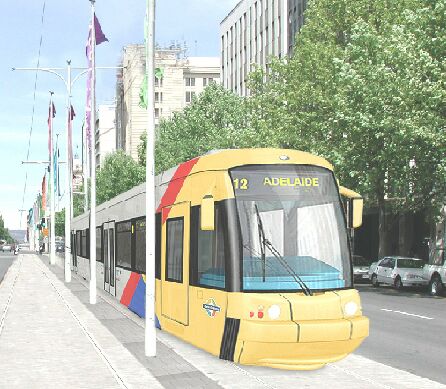
Light Rail Progress can be contacted at: Light Rail Progress |
Light Rail Tramway Development Moves to Forefront
How times have changed... Since 2003, Adelaide's public transport perspective and emphasis have dramatically shifted, refocusing on LRT technology and the heritage Glenelg tramway, which is now the recipient of a substantial upgrading and expansion program. Not only is the tramway being modernized, with 9 state-of-the-art Bombardier Flexity LRT tramcars (described as "supertrams"), plus upgraded stations and trackage, but Adelaide's city and transport leadership have also decided to extend the line 1.2 km (0.75 mile) into the city's central business district.
"Trams will be running down King William St and North Tce by 2007" reported the Adelaide Advertiser (6 April 2005), noting that "The $21 million extension of the Glenelg line will be the first new tram line in South Australia since the 1920s." According to the report, construction of the short connecting segment of track into the city center is scheduled to commence in 2006. The extension follows a route around the eastern edge of Victoria Square, down the middle of King William St., then down North Tce to a final terminus at Adelaide Railway Station. The project includes installing four new station-stops: in Victoria Square and Pirie St., and at Rundle Mall and the railway station. All told, the upgrade and extension project is expected to cost A$93 million (approximately US $71 million). Of this, more than A$72 million is allocated for the new trams and upgrading of the existing Glenelg line. In terms of unit capital costs, the total cost (based on a total project line length of 12.0 km/7.4 miles) calculates to about US $6 million/km, or about $10 million per mile. Interestingly, this is less than what the supposedly "cheaper" O-Bahn "BRT" cost – but those were "BRT" costs from about 20 years ago! (However, it must be noted that, except for the new CBD segment, the LRT project is an upgrade of an existing public transportation facility, whereas the O-Bahn was installed from scratch.) Currently, the Glenelg tramway extends 10.8 kilometers (6.7 miles) from Victoria Square, in the City, to Adelaide's most popular beachside center, Glenelg – a journey which takes approximately 30 minutes, with trams currently travelling at speeds of up to 80 kilometers per hour (50 mph). (That calculates to an average schedule speed of about 13 mph/21 kph.) The fleet consists of 21 of the original 30 H-type trams dating from the 1920s. Five of the historic trams used on the Glenelg line will be retained, but used only on weekends and public holidays.
Each H-type tram is 16.5 meters (54.4 feet) in length and has the capacity to carry a total of 94 passengers (64 seated and standing room for another 30). Frequently, during peak periods and other times of heavy passenger volumes, coupled trains of two trams are operated together in multiple-unit. Each H-type tram is powered by four 65 HP, 600-volt DC motors. The line's new Bombardier "supertrams" are reported to seat up to 80 passengers, and to be designed to provide full accessibility for disabled passengers (a drawback of the heritage rolling stock). They're also fully air-conditioned and are described as "super-quiet". The first of these railcars are expected to be placed in operation by late 2005 or early 2006.
Logistical problems of the "BRT" may also have contributed to its diminished esteem in the eyes of local community leaders and public transport officials and planners. Australian public transport consultant Dudley Horscroft relates that "A major problem with the Adelaide system is that the buses are dumped into the congested city streets at the end of the O-Bahn, and congestion makes for slow and erratic performance in the City Centre." Thus, as soon as the O-Bahn buses get to the edge of the CBD they have to leave the guideway to run on ordinary traffic lanes, with consequent delays due to traffic congestion. The strange Adelaide saga of an aborted LRT project, its replacement by "BRT", and now the return of LRT into favor, has relevance for public transport planning elsewhere. One of the lessons is succinctly summed up by Brent Efford, Coordinator of New Zealand's Transport 2000+ organization:
Some material in this report has been adapted from information on the website of TransAdelaide. Light Rail Now! website |
|
|
|